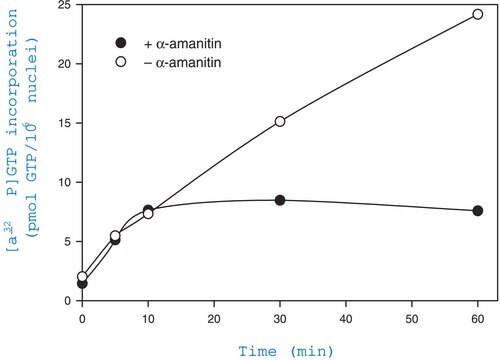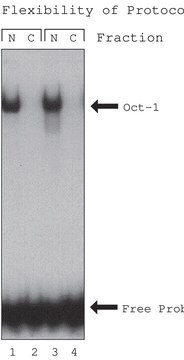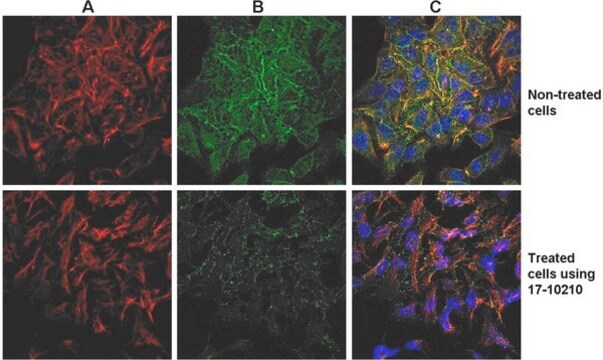17-10195
Kit d'enrichissement et d'isolement du cytosquelette ProteoExtract®
This kit provides cytoskeleton purification detergent buffers, sufficient for extraction from ten 100 mm culture dishes, that retain focal adhesion & actin-associated proteins while removing soluble cytoplasmic & nuclear proteins from the cell.
Se connecterpour consulter vos tarifs contractuels et ceux de votre entreprise/organisme
About This Item
Code UNSPSC :
12161503
eCl@ss :
32161000
Produits recommandés
Fabricant/nom de marque
Chemicon®
ProteoExtract®
Technique(s)
western blot: suitable
Conditions d'expédition
dry ice
Description générale
Read our application note in Nature Methods!
http://www.nature.com/app_notes/nmeth/2012/121007/pdf/an8624.pdf
(Click Here!)
Rediscovering the Actin Cytoskeleton: New techniques leading to discoveries in cell migration, Dr. Richard Klemke, Morris Cancer Center, UCSD, USA.
The actin cytoskeleton is a highly dynamic network composed of actin polymers and a large variety of associated proteins. The functions of the actin cytoskeleton is to mediate a variety of essential biological functions in all eukaryotic cells, including intra- and extra-cellular movement and structural
Support (Chen, C.S., et al., 2003; Frixione E., 2000). To perform these functions, the organization of the actin cytoskeleton must be tightly regulated both temporally and spatially. Many proteins associated with the actin cytoskeleton are thus likely targets of signaling pathways controlling actin assembly. Actin cytoskeleton assembly is regulated at multiple levels, including the organization of actin monomers (G-actin) into actin polymers and the superorganization of actin polymers into a filamentous network (F-actin – the major constituent of microfilaments) (Bretscher, A., et al., 1994). This superorganization of actin polymers into a filamentous network is mediated by actin side-binding or cross-linking proteins (Dubreuil, R. R., 1991; Matsudaira, P., 1991; Matsudaira, P., 1994). The actin cytoskeleton is a dynamic structure that rapidly changes shape and organization in response to stimuli and cell cycle progression. Therefore, a disruption of its normal regulation may lead to cell transformations and cancer. Transformed cells have been shown to contain less F-actin than untransformed cells and exhibit atypical coordination of F-actin levels throughout the cell cycle (Rao, J.Y., et al., 1990). Orientational distribution of actin filaments within a cell is, therefore, an important determinant of cellular shape and motility.
Focal adhesion and adherens junctions are membrane-associated complexes that serve as nucleation sites for actin filaments and as cross-linkers between the cell exterior, plasma membrane and actin cytoskeleton (Yamada, K.M., Geiger, B., 1997). The function of focal adhesions is structural, linking the ECM on the outside to the actin cytoskeleton on the inside. They are also sites of signal transduction, initiating signaling pathways in response to adhesion. Focal adhesions consist of integrin-type receptors that are attached to the extracellular matrix and are intracellularly associated with protein complexes containing vinculin (universal focal adhesion marker), talin, α-actinin, paxillin, tensin, zyxin and focal adhesion kinase (FAK) (Burridge, K., et al., 1990; Turner, C.E., Burridge, K., 1991).
Studying the proteins that associate with and regulate the actin cytoskeleton has been traditionally difficult because of the insolubility of the cytoskeleton in traditional detergents like Triton-X100. Work over the years has shown that many actin regulatory proteins/phospho-proteins upon activation move from the soluble cytoplasmic compartment to the insoluble actin cytoskeleton. The insolubility of these important proteins has made it difficult to study their biochemical changes, such as phosphorylation and nitrosylation, upon binding to actin. What is sorely needed is a cytoskeleton purification method that allows for the selective enrichment of cytoskeleton-associated proteins for detailed protein biochemical analyses. Such a method would provide the means to directly study this important pool of proteins in normal and diseased cytoskeletons.
http://www.nature.com/app_notes/nmeth/2012/121007/pdf/an8624.pdf
(Click Here!)
Rediscovering the Actin Cytoskeleton: New techniques leading to discoveries in cell migration, Dr. Richard Klemke, Morris Cancer Center, UCSD, USA.
The actin cytoskeleton is a highly dynamic network composed of actin polymers and a large variety of associated proteins. The functions of the actin cytoskeleton is to mediate a variety of essential biological functions in all eukaryotic cells, including intra- and extra-cellular movement and structural
Support (Chen, C.S., et al., 2003; Frixione E., 2000). To perform these functions, the organization of the actin cytoskeleton must be tightly regulated both temporally and spatially. Many proteins associated with the actin cytoskeleton are thus likely targets of signaling pathways controlling actin assembly. Actin cytoskeleton assembly is regulated at multiple levels, including the organization of actin monomers (G-actin) into actin polymers and the superorganization of actin polymers into a filamentous network (F-actin – the major constituent of microfilaments) (Bretscher, A., et al., 1994). This superorganization of actin polymers into a filamentous network is mediated by actin side-binding or cross-linking proteins (Dubreuil, R. R., 1991; Matsudaira, P., 1991; Matsudaira, P., 1994). The actin cytoskeleton is a dynamic structure that rapidly changes shape and organization in response to stimuli and cell cycle progression. Therefore, a disruption of its normal regulation may lead to cell transformations and cancer. Transformed cells have been shown to contain less F-actin than untransformed cells and exhibit atypical coordination of F-actin levels throughout the cell cycle (Rao, J.Y., et al., 1990). Orientational distribution of actin filaments within a cell is, therefore, an important determinant of cellular shape and motility.
Focal adhesion and adherens junctions are membrane-associated complexes that serve as nucleation sites for actin filaments and as cross-linkers between the cell exterior, plasma membrane and actin cytoskeleton (Yamada, K.M., Geiger, B., 1997). The function of focal adhesions is structural, linking the ECM on the outside to the actin cytoskeleton on the inside. They are also sites of signal transduction, initiating signaling pathways in response to adhesion. Focal adhesions consist of integrin-type receptors that are attached to the extracellular matrix and are intracellularly associated with protein complexes containing vinculin (universal focal adhesion marker), talin, α-actinin, paxillin, tensin, zyxin and focal adhesion kinase (FAK) (Burridge, K., et al., 1990; Turner, C.E., Burridge, K., 1991).
Studying the proteins that associate with and regulate the actin cytoskeleton has been traditionally difficult because of the insolubility of the cytoskeleton in traditional detergents like Triton-X100. Work over the years has shown that many actin regulatory proteins/phospho-proteins upon activation move from the soluble cytoplasmic compartment to the insoluble actin cytoskeleton. The insolubility of these important proteins has made it difficult to study their biochemical changes, such as phosphorylation and nitrosylation, upon binding to actin. What is sorely needed is a cytoskeleton purification method that allows for the selective enrichment of cytoskeleton-associated proteins for detailed protein biochemical analyses. Such a method would provide the means to directly study this important pool of proteins in normal and diseased cytoskeletons.
Application
Ce kit fournit des tampons détergents pour la purification du cytosquelette, en quantité suffisante pour l'extraction de dix boîtes de culture de 100 mm. Ces tampons retiennent les protéines d'adhésion focale et les protéines associées à l'actine tout en éliminant les protéines solubles cytoplasmiques et nucléaires de la cellule.
Domaine de recherche
Structure cellulaire
Structure cellulaire
Le kit d'enrichissement et d'isolement du cytosquelette ProteoExtract® d'EMD Millipore fournit des tampons détergents pour la purification du cytosquelette, en quantité suffisante pour l'extraction de dix boîtes de culture de 100 mm. Ces tampons retiennent les protéines d'adhésion focale et les protéines associées à l'actine tout en éliminant les protéines solubles cytoplasmiques et nucléaires de la cellule. Les anticorps anti-Vimentine et anti-GAPDH sont fournis respectivement comme marqueurs du cytosquelette et du cytosol dans l'analyse par western blotting. Ce kit améliore considérablement la capacité à détecter et à étudier les protéines associées à l'actine de faible abondance, lesquelles sont généralement masquées dans les méthodes classiques d'analyse par western blotting des lysats de cellules entières.
Sous-domaine de recherche
Cytosquelette
Cytosquelette
Conditionnement
Quantité de réactifs permettant d'effectuer 15 réactions/isolements
Composants
Un flacon contenant 1,9 ml de tampon d'extraction cellulaire 10x
Un flacon contenant 3,5 ml de tampon de lavage pour cytosquelette 20x
Un flacon contenant 9 ml de tampon d'extraction nucléaire prêt à l'emploi
Deux flacons contenant chacun 100 µl de solution cocktail d'inhibiteurs de protéases 1 000x
Un flacon contenant 150 µl de solution d'orthovanadate de sodium 1 000x
Un flacon contenant 3,8 ml de tampon de solubilisation du cytosquelette prêt à l'emploi
Un flacon contenant 30 µl d'anticorps de chèvre anti-souris conjugué à de la HRP 2 000X
Un flacon contenant 50 µl d'anticorps monoclonal de souris IgG1 anti-GAPDH 1 000x
Un flacon contenant 100 µl d'anticorps monoclonal de souris IgG1 anti-Vimentine 500x
Un flacon contenant 3,5 ml de tampon de lavage pour cytosquelette 20x
Un flacon contenant 9 ml de tampon d'extraction nucléaire prêt à l'emploi
Deux flacons contenant chacun 100 µl de solution cocktail d'inhibiteurs de protéases 1 000x
Un flacon contenant 150 µl de solution d'orthovanadate de sodium 1 000x
Un flacon contenant 3,8 ml de tampon de solubilisation du cytosquelette prêt à l'emploi
Un flacon contenant 30 µl d'anticorps de chèvre anti-souris conjugué à de la HRP 2 000X
Un flacon contenant 50 µl d'anticorps monoclonal de souris IgG1 anti-GAPDH 1 000x
Un flacon contenant 100 µl d'anticorps monoclonal de souris IgG1 anti-Vimentine 500x
Stockage et stabilité
Conserver les modules du kit non ouverts (réf. 17-10195-1 et 17-10195-2) aux températures indiquées. Le kit peut être utilisé jusqu'à 4 mois après la date de réception. Éviter les congélations/décongélations répétées ; aliquoter si nécessaire.
Informations légales
CHEMICON is a registered trademark of Merck KGaA, Darmstadt, Germany
PROTEOEXTRACT is a registered trademark of Merck KGaA, Darmstadt, Germany
Clause de non-responsabilité
Sauf indication contraire dans notre catalogue ou toute autre documentation associée au(x) produit(s), nos produits sont uniquement destinés à la recherche et ne sauraient être utilisés à d'autres fins, ce qui inclut, sans s'y limiter, les utilisations commerciales non autorisées, les utilisations diagnostiques in vitro, les utilisations thérapeutiques ex vivo ou in vivo, ou tout type de consommation ou d'application chez l'être humain ou chez l'animal.
Mention d'avertissement
Warning
Mentions de danger
Conseils de prudence
Classification des risques
Acute Tox. 4 Oral - Aquatic Chronic 3 - Eye Irrit. 2 - Skin Irrit. 2 - Skin Sens. 1
Code de la classe de stockage
10 - Combustible liquids
Certificats d'analyse (COA)
Recherchez un Certificats d'analyse (COA) en saisissant le numéro de lot du produit. Les numéros de lot figurent sur l'étiquette du produit après les mots "Lot" ou "Batch".
Déjà en possession de ce produit ?
Retrouvez la documentation relative aux produits que vous avez récemment achetés dans la Bibliothèque de documents.
Viorica L Lastun et al.
The Journal of biological chemistry, 298(6), 101935-101935 (2022-04-19)
In metazoans, the architecture of the endoplasmic reticulum (ER) differs between cell types and undergoes major changes throughout the cell cycle and according to physiological needs. Although much is known about how the different ER morphologies are generated and maintained
Notre équipe de scientifiques dispose d'une expérience dans tous les secteurs de la recherche, notamment en sciences de la vie, science des matériaux, synthèse chimique, chromatographie, analyse et dans de nombreux autres domaines..
Contacter notre Service technique









